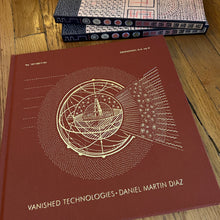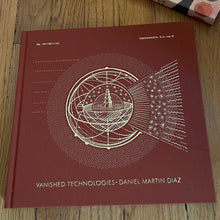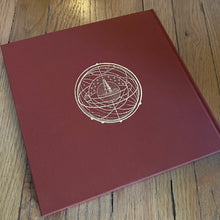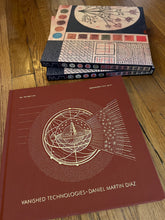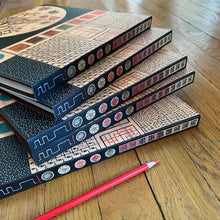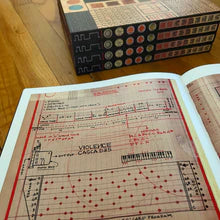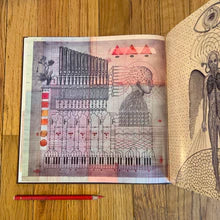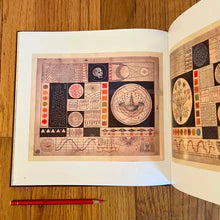
Vanished Technologies
By Daniel Martin Diaz
Second Edition, 10"x10", 134 Pages, 103 Images, Rust Italian Cloth, Gold Foil Cover, Binder Slipcase
New in the second edition: Rust Cover Italian Cloth.
Essay from Vanished Technologies
A Language All His Own
By Zara Kand
Vanished Technologies: a poignant title for this vast collection of works by Daniel Martin Díaz. Throughout, he reveals the interconnection of a broad range of subjects such as ancient machinery, the cosmos, biology, the human dilemma, and extraterrestrials. These highly detailed drawings by the acclaimed Tucson-based artist offer an illuminating connection between the mysteries of science and spirituality, yet the message is tantalizingly cryptic. Drawing inspiration from an array of concepts found in the studies of anatomy, computer science, math, cosmology, biology, religion, quantum physics, and human consciousness, Díaz gives us many onion layers to peel back. Any attempt to do so, however, is best approached with humility.
Díaz’s works often resemble scientific charts, with symbols and figures conveying relationships, yet they are articulated through a language all his own. Imagery such as nuclei, celestial bodies, and cross sections of the human body all point to a fascination with micro and macro realms. As an example, in Universal Sekret a large, planet-shaped schematic diagram bordering Christ’s halved face joins a network of capillaries and extended vascular and botanical imagery. Beneath are the words “To be human is tragic in this cosmic drama.”
Other contemplations include things we cannot see, such as frequency transmission, psychic connection, traces of primeval memory. Despite existing within the invisible realm, they serve as important pieces in the grand puzzle. This plethora of works were crafted with a combination of mediums including oil, gouache, graphite, ink, watercolor, and grease pencil rendered on found paper and wood.
Reminiscent of artifacts mined from a long-lost era, a faded, old-world atmosphere is manifested through Diaz’s vision. This is no surprise considering that other influences include Byzantine iconography, retablos, ephemera, alchemy, arcane religious sigils and medallions, and 16th century anatomical engravings. Merging nostalgia with prophecy, Díaz manages to bridge the ancient and modern worlds with such questions as how our use or misuse of technology might permanently alter the future of humanity and what is our personal responsibility towards our effect on the world and each other. To top all this off, UFOs spring up here and there as reminder that there is far more to ponder than human experience.
Daniel Martin Díaz has exhibited worldwide and has been published in the Los Angeles Times, the New York Times, Juxtapoz, High Fructose, Low Rider Magazine, and others. Years of disciplined practice have taught him that deep concepts are best conveyed through visual symbolic logic: these ideas would otherwise take pages of text to explain and might never adequately be verbalized.
———-
In recent years, Diaz became immersed in scientific and philosophical theories. In particular, he became obsessed with scientific diagrams, which explain theories and properties through drawings. Although these rudimentary drawings were without any leanings towards aesthetics, he found them to be beautiful, though that is clearly not their intention. He was inspired to use the simplicity of drawing to create his own interpretations of the concepts of consciousness and other theories on a scientific, philosophical, and spiritual level. All of the projects begin as drawings, which have a beauty and intimacy that paintings cannot capture. Graphite’s allure comes from its subtle lines and the quickness in which one can capture an idea.
———-
Book Detail:
Vanished Technologies
By Daniel Martin Diaz
Contributors: Aarne Anton, Zara Kand, David Walker Ph.D., Greg Golden.
“The laws of physics are the new miracles, quantum physics is the new witchcraft, and modern chemistry is the new alchemy.” –Diaz
“Diaz’s art has a strange mélange of ancient and contemporary. Part iconic, part emotionally laden and sorrowful lament.” –Raw Vision Magazine (UK)
[Diaz] is able to hold the “impossible” in his mind and then express it with utter crispness. From imagining the connections underlying consciousness to blueprinting extraterrestrial encounters.” –David Pescovitz
———–
Vanished Technologies
ISBN: 978-1-7923-7727-3 | Hard Cover
10 x 10 134 Pages, 2022
Art/Science
Published by 333 Publishing









